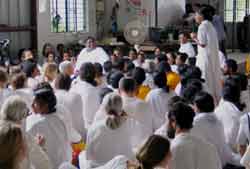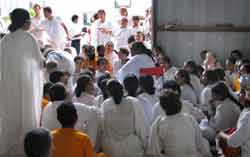
December 21, 2005 — auto-parts factory and repair facility, just off NH45, Pondicherry
About halfway to Chennai from Nagapattinam, one of the vehicles in Amma’s caravan began showing signs of engine trouble. It was also past time for lunch. So when the caravan passed by a large auto-parts factory and engine-repair facility, Amma instructed everyone to pull over and inquire if the group could have its lunch there.
To everyone’s surprise, the factory was owned by one of Amma’s devotees who had actually come for Amma’s darshan the night before in Nagapattinam. During his darshan he had asked Amma to come visit his home on her way to Chennai. However, Amma had told him that such a visit was impossible, as there was no time.
You can imagine the surprise of the devotee when his employees called him and told him that Amma had suddenly appeared at his place of business! He immediately gathered his wife and two daughters, and 10 minutes later they were all sitting at Amma’s feet with the rest of Amma’s disciples and devotees.
After giving everyone prasad in the form of curd rice and curry, one of Amma’s brahmacharinis began to tell a story. It was the lead-in tale of Kathopanishad, the Vedic teaching delivered by Yama Dharmaraja, the Lord of Death, to a young Brahmin boy.
Almost verse by verse, the brahmacharini related the story of how Nachiketas came to leave the earthly plane and visit Lord Death in his abode. She explained how, in fact, when the boy reached there, Death was not home and how Nachiketas had to wait three days for him to return. For each day he was forced to wait, Death granted Nachiketas a boon.
For his first boon, Nachiketas asked that his father accept him upon his return to the earthly plane. For his second boon, he asked Yama to teach him a fire ritual that when correctly performed would take one to heaven. And for his third boon, he said, “What happens after death? Is there a soul surviving death, or is it total annihilation?”
Death told him, “Please, I will give you anything you desire: heavenly damsels, gold, sons, cattle. Ask me anything but this.”
To which Nachiketas responded, “Keep your damsels and long life, all I want to know is this secret.”
Finally, impressed by the Nachiketas dispassion, Death began imparting his precious secret.
But at this point, the brahmacharini stopped the story, saying that she could not proceed further as, like Lord Death had said, the knowledge was a secret.
This is where Amma came in.

Amma said that the Vedantic teachings regarding the ultimate reality are not given out to just anyone. Only upon being convinced of the mental maturity of the student will the Guru begin to undertake such a teaching. If Vedanta is taught to one who is not mature enough, it will be wasted or could even result in harm.
In order to illustrate this point, Amma told two stories.
The first one involved a disciple who’d recently been taught that everything in creation in truth is nothing other than Brahman, the pure eternal unlimited consciousness that pervades all of creation. Elated with his new knowledge, the disciple walked around continually reminding himself that everything he saw was Brahman. In the midst of his revelry, he heard someone shout, “Everyone run! A mad dog is coming!” However, the disciple did not react. “If everything is Brahman, then this dog too is Brahman only,” he told himself. “What is the point of getting out of the way?” No sooner had he finished his thought than the mad dog appeared on the scene. It promptly ran up to the disciple and bit him. Later, the Guru stood at the disciple’s side, tending to his wounds. “When everyone was telling you a mad dog was coming, why didn’t you run?” the Guru asked. The disciple told him his reasoning. The Guru quickly rebuffed him: “If you could see the mad dog as Brahman, why didn’t you see the person who was telling you to run as Brahman also?”
Amma then told everyone that the scriptures say there are three types of disciples: the uttama adhikari, the madhya adhikari and the adhama adhikari the top, the middle and the lowest.
Amma’s second story went like this: Once upon a time, there was a great Vedantic scholar whose prized possession was a parrot that he’d taught to chant all of the Vedas. One day while walking through the forest, this scholar was attacked by a ferocious lion. At the last possible second before the lion fell upon the scholar, a forest-dwelling hunter suddenly appeared and shot the lion dead. The scholar told the hunter that he now owed him his very life and as such he wanted to give him something—his prized parrot.
The hunter and the scholar then parted. But it wasn’t long before the scholar began lamenting having given his parrot away. It was such a rare and valuable possession. He simply could not stop thinking about the parrot and wondering how it was faring with its new owner.
After a few months, the scholar again was walking through the forest. There, he once again happened to cross paths with the hunter. He was elated. “How is my parrot?” he asked, hoping to get him back. The hunter just smiled and rubbed his belly: “Oh, he made an excellent meal!”
Amma said that if Vedanta is taught to someone who is not mature enough to understand, he will only use the knowledge as to his level of understanding.
“A mother gives breast milk to her baby, not meat,” Amma said. “Similarly, such knowledge should be imparted only to those who are mature enough to receive it.
Amma also said that in today’s world many people go around repeating, “I am Brahman, I am Brahman,’ but they have no such experience. Amma compared such foolishness to licking the word “honey” written on a piece of paper and expecting to get sweetness from it. Similarly, she said, “A picture of a cow won’t eat any grass or give us any milk.”
In today’s world, it is common to come across people who misinterpret Vedanta and—consciously or subconsciously—twist the philosophy in order to fulfill their selfish desires. Instead of acting according to the principles of the philosophy, they use the philosophy to justify their actions. As Amma often says, we should not leave Vedanta confined to the pages of books. We need to live Vedanta, letting the philosophy shine forth in all of our actions.
-Sakshi
